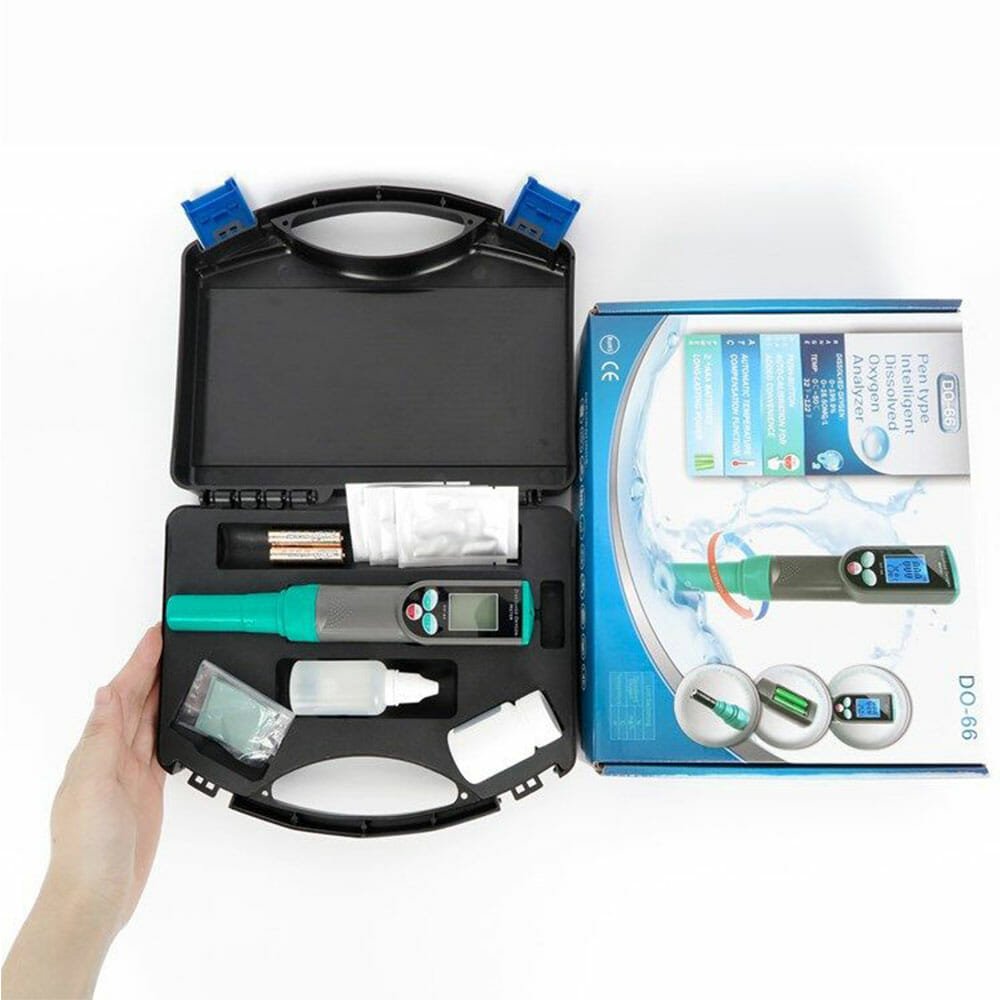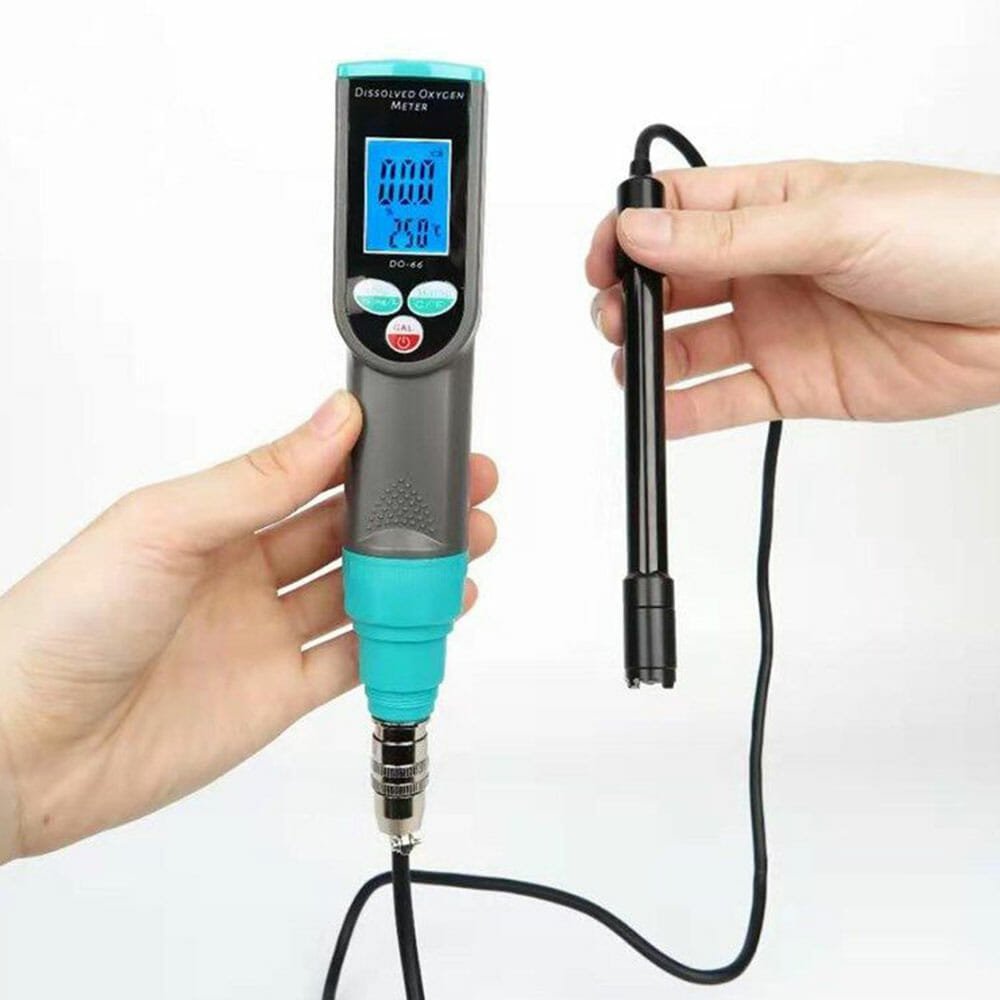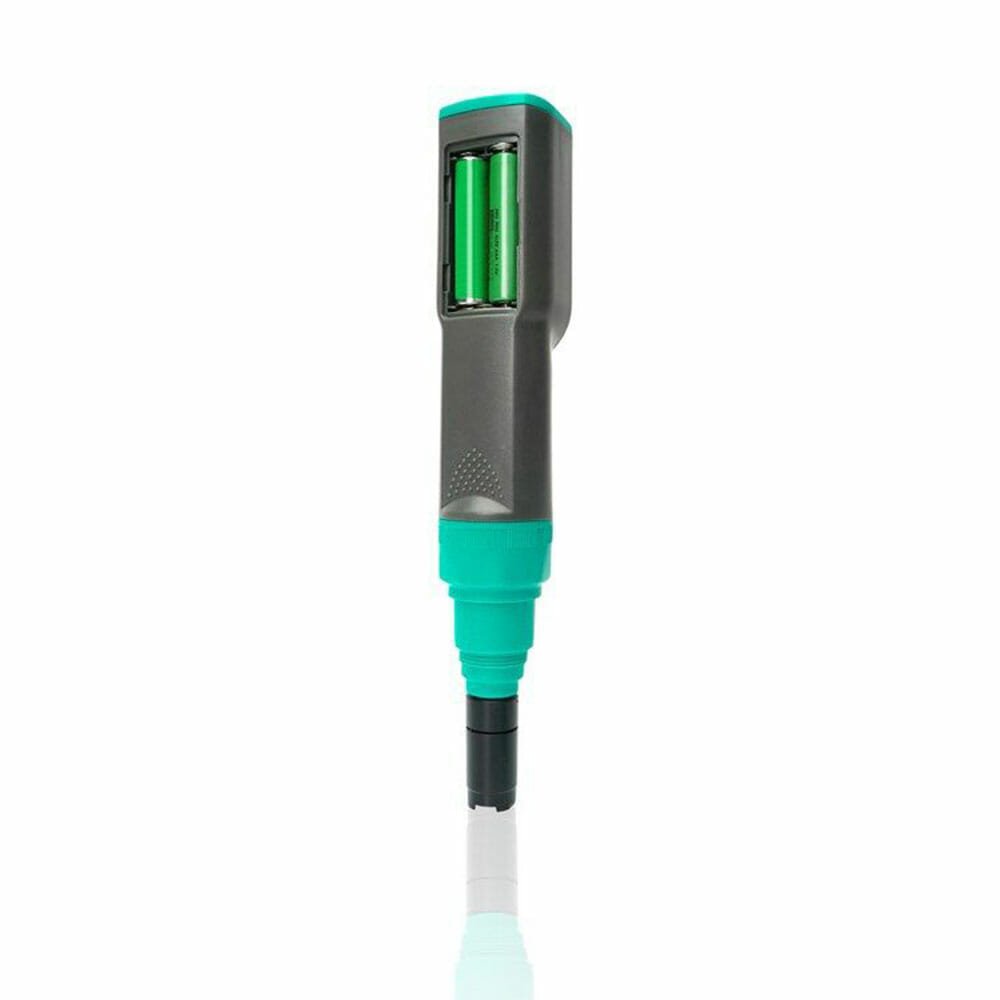Many bacteria living in water require dissolved oxygen (DO). As a result, it is critical to maintain optimum dissolved oxygen concentrations in artificial facilities such as wastewater treatment plants and fish farms. Dissolved oxygen is also a good indicator of pollution levels in rivers, lakes, and marshes.
This metre is the most recent high-functioning and high-performance model of our bubble cleaning type DO metre, which has been developed over many years using our knowledge. This metre can be used in river basins with float type detectors. The pet fish industry is just one of the many reasons we use dissolved oxygen metres to monitor the oxygen levels in our water, but it’s a big one! Learn everything you need to know about oxygen in water and how to detect it by reading our simple summary.
1. What is a DO meter?
The amount of dissolved oxygen in a liquid is measured using dissolved oxygen (DO) metres. Aeration, as a result of photosynthesis, and from the surrounding air all contribute to the presence of oxygen in water. Any healthy aquatic system that can support aerobic life must have a specific level of oxygen; normally, healthy bodies of water have at least 5 mg/L of dissolved oxygen. DO levels of less than 5 mg/L can cause aquatic species to become stressed, and levels as low as 1 mg/L for simply a few hours can cause widespread fish mortality.
Dissolved oxygen saturation, on the other hand, can be hazardous to aquatic life. When considering the information presented above, it is evident that measuring dissolved oxygen is critical when assessing the health and sustainability of aquatic ecosystems.
We’re used to substances such as salt dissolving in water. However, gases such as oxygen can be dissolved in water. The air is always in contact with our oceans and rivers. Pure oxygen makes up about 21% of the air we breathe. Some of the oxygen is dissolved into the water just by contacting it. As you might expect, the same process applies to other gases in the air, such as carbon dioxide, resulting in carbon dioxide and other gases being dissolved in water.

2. Importance of dissolved oxygen
Fish don’t truly breathe water, at least not in the way we think of it. Fish, like people and other terrestrial animals, require oxygen to survive.
Fish obtain their oxygen directly from the water, but we get ours from the atmosphere. To power their bodies, fish take in water and extract oxygen from it. Water life is unhealthy if there isn’t enough oxygen. Fish life becomes impossible if oxygen levels fall too low.
3.How can we measure dissolved oxygen?
The Optical Sensor technique, the Polarographic method, the Pulsed Polarographic method, and the Galvanic method are the four methods for measuring dissolved oxygen.
3.1 Optical Sensor Method
Optical sensors are a convenient solution because they do not require incoming water flow or membrane replacement on a regular basis. They can be reused numerous times. The fact that liquid oxygen interferes with certain luminous dyes is used by optical sensors. The sensor has two parts: one that creates light and the other that detects it. The detected light will be weaker or stronger depending on whether there is more or less oxygen in the water.

You can tell how much oxygen is in the water by measuring how bright the light is.These sensors mainly monitor the dissolved oxygen pressure in the sample. These sensors, for starters, monitor the pressure of oxygen dissolved in a sample. DO percent is the sole variable that impacts ‘raw’ readings, and the only variable that influences DO percent is barometric pressure. The more oxygen is pumped into the water, the higher the barometric pressure. It is worth noting that the DO in mg/L is determined based on the percentage of oxygen, temperature and salinity.
Like electrochemical sensors, optical sensors do not require any chemicals. When taking a measurement, both types of sensors are inserted directly in the sample. The brightness of the dye layer is affected by the movement of oxygen through the diffusion layer. The lifespan of the luminescence in the sensing layer is inversely related to the amount of oxygen travelling through it. The sensor measures the luminescence lifespan and compares it to the reference to estimate DO
3.2 Polarographic method
Polarographic sensors generate an electrical current using oxygen in the water and a cathode. You can find out how dense the oxygen in the water is by monitoring how strong the current is. A silver anode and a gold cathode are used in polarographic sensors. Before using these materials, the probe must be heated or polarized, which takes about 10 minutes. Because polarographic sensors are not always active, they have a longer lifespan than galvanic sensors (i.e., not always polarized).

3.3 Pulsed Polarographic method
The pulsed polarographic approach creates an electric current by using the oxygen in water. It allows you to measure oxygen levels without stirring by pulsing its sensors on and off every few seconds
3.4 Galvanic method
The galvanic approach makes measuring dissolved oxygen simple. All you have to do is submerge a tab containing particular chemicals in water. The oxygen in the water reacts with the tab, changing its colour. You can determine how much oxygen is in the water based on the exact tint and colour of the utilised tab.
A zinc anode and a silver cathode are used in galvanic sensors. These materials ensure that the sensor remains polarized even when the meter is turned off, so there is no need for a warm-up phase. There is a disadvantage of always-on: these sensors have a shorter lifespan than polarographic sensors.
3.5 Colorimetric Method
Colorimeters, commonly known as filter photometers, are colour intensity measuring equipment. Chemical reagents are combined with the sample when utilising these equipment. The solution will have a colour if the target parameter is present, and the intensity of the colour will be proportional to the concentration of the parameter being tested.
The light detector is illuminated by passing light through a tube containing the sample solution and then through a color filter. The filter is used to filter light with a specific wavelength. All of the light passes through when the solution is colourless. When a colored sample absorbs light, the amount of light passing through the sample decreases accordingly.
Indigo Carmine and Rhodazine D are the two colorimetric methods for determining DO. DO interacts with indigo carmine to form a blue complex. Rhodazine D, on the other hand, forms a vivid pink complex when it combines with DO.
3.6 Winkler Titration
When using a Winkler titration to determine DO concentrations, reagents are also used. The reagents form acidic compounds, which are titrated with neutralizing chemicals in the process. When a color change occurs, such as colorimetric focusing, the DO concentration is measured by observing the point where the color change occurs.
Many standard operating procedures (SOPs), particularly in wastewater treatment labs evaluating biological oxygen demand, still call for a Winkler titration (BOD). The flash must be executed 3 times, and the results are averaged.
3.7 Electrochemical Sensors
Electrochemical sensors, also known as membrane-covered DO sensors, do not require reagents, unlike Winkler titrations or colorimeter measurements of DO. These sensors have long distances and provide fast measurements, but water must constantly flow through the membrane because oxygen is consumed during the measurement.
With YSI instruments like the ProQuatro and Pro20, either sensor type can be used. An anode and a cathode are contained in electrolyte solution by an oxygen-permeable membrane in electrochemical DO sensors. Oxygen molecules in the sample diffuse through the membrane before being consumed (reduced) at the cathode. This reaction generates an electrical signal, which passes from the cathode to the anode and then to the instrument/meter.
The partial pressure and concentration of oxygen outside the membrane are proportional to the amount of oxygen diffusing through the membrane. The oxygen diffusing through the membrane fluctuates in proportion to the oxygen concentration, causing the probe current to change proportionately.
4.What to Look for When Choosing a Dissolved Oxygen Sensor?
There are various methods for measuring dissolved oxygen in water, and choosing the best one for you can be difficult for individuals who are new to measuring DO. When the only parameter being measured is dissolved oxygen, colorimeters are not commonly employed because they are inconvenient to use – mixing the reagent and solution takes time! In addition, the measurement range has some rather strict restrictions.
Winkler titrations are time consuming and difficult to complete. Assume you’re required to do a Winkler titration as part of your standard operating procedure (SOP), which is based on ISO 5813 or ASTM D888.
Instead of completing the titrations by hand, we propose utilising an automatic titrator – check out some titration choices from YSI. If you have a choice, we recommend utilising an electrochemical or optical sensor for DO measurement if you need to measure DO in situ or have a large throughput of samples.
When it comes to detecting DO, electrochemical and optical sensors are by far the most popular tools. DO sensors, unlike other water quality sensors (e.g., nitrate), are generally built for a specific application. They can be utilised in surface water, aquaculture, groundwater, wastewater, and more!
5. Factors affecting Natural DO levels:
A number of natural factors can have an impact on dissolved oxygen levels, including:
● Aquatic life (less DO = greater aquatic life)
● Levels of breakdown (decomposition processes consume oxygen, resulting in less DO)
● Type of water body (running streams dissolve more oxygen than still water)
● High altitude equals less DO.
Temperature, barometric pressure, photosynthesis and salinity all influence dissolved oxygen concentrations in water.
5.1 Salinity
The solubility of oxygen in water is inversely proportional to the salt content, as is the temperature: the oxygen content decreases as the salt content increases.
For example, at the same temperature and pressure, the oxygen content of sea water may be 20% less than that of fresh water. When collecting DO data in estuaries, wetlands, coastal areas, aquaculture, or other applications with high salinity can vary, it’s vital to measure salinity – which can be done with a conductivity sensor. More information on the effect of salinity on DO may be found in the Comparing Dissolved Oxygen Measurement Units section.
When the conductivity sensor and DO are paired, most modern DO instruments such as YSI ProDSS provide real-time salinity compensation DO data. In order for this adjustment to occur, salinity must be entered into the metre.
5.2 Temperature
Temperature is the most important variable and must be measured together with dissolved oxygen. The solubility of oxygen in water is inversely proportional to temperature, and DO decreases with increasing temperature. Assuming all other variables remain constant, a water body will have a higher DO content in the winter than in the summer. It is the same at night: as the water cools, more oxygen dissolves. It’s vital to remember, though, that photosynthesis and respiration have an impact on DO levels both during the day and at night.
Dissolved oxygen levels are rarely stable, fluctuating with seasonal, temperature, and time of day changes. DO levels vary even within a single body of water, either vertically (in lakes or huge rivers) or horizontally (inside the waterway) (in smaller rivers and streams).
The time of day and temperature, in particular, have a significant impact on dissolved oxygen levels, partly due to the fact that cold water has more dissolved oxygen than warm water. A measurement obtained before sunrise, when water temperatures are at their lowest, could be more than one full mg/L greater than one taken at midday, when water temperatures are at their highest.
As a result, rather than relying on a single measurement, researchers frequently record hourly DO samples over the course of a 24-hour period and develop a dissolved oxygen profile of a lake or river. Variations in dissolved oxygen levels caused by temperature changes are largely mitigated by changes in solar activity, which influences dissolved oxygen levels in the opposite direction.
5.3 Barometric Pressure
Unlike temperature and salinity, barometric pressure and DO levels in water have a direct relationship: as pressure lowers, DO decreases. The air pressure is higher at lower altitudes, so the pressure to bring oxygen from the atmosphere into the water is higher. The barometric pressure, on the other hand, is substantially lower at greater heights. In addition to altitude, changes in weather can affect barometric pressure. A sudden drop in pressure can signal the arrival of a storm. Most modern oxygen meters have a built-in air pressure sensor that automatically compensates for the oxygen measurement value when the air pressure changes.
5.4 Photosynthesis
Increased levels of photosynthesis result in higher levels of dissolved oxygen, as indicated in the image above. Because photosynthesis improves with more sunshine, the process results in higher DO levels during daytime hours, regardless of water temperature effects.
DO levels tend to fall during night, when photosynthetic activity drops and breakdown proceeds, regardless of temperature. DO levels are clearly determined by intricate interplay of environmental and biological factors inside a body of water, given the various variables described above.
6. What are the devices for measuring DO?
Dissolved oxygen metres are similar to pH metres in that they have a DO probe coupled to a meter/analyzer. The probe consists of two electrodes suspended in a potassium chloride (KCl) electrolyte solution and surrounded by glass and/or semi-permeable membrane. The electrodes are attached to the metre, which sends a tiny DC current through cabling to the electrodes. When the sensor is submerged in liquid, oxygen from the liquid passes through the membrane and reacts with the cathode, resulting in a quantifiable current change that is translated into a millivolt output and shown by the metre. Dissolved oxygen metres, like pH metres, generally monitor more than just DO. pH, oxygen reduction potential (ORP), temperature, conductivity, and other liquid quality parameters can all be measured with multifunction metres.
Cleaning and maintaining a dissolved oxygen probe works similarly to cleaning and maintaining a pH probe. Maintaining accurate metre output requires ensuring correct electrolyte solution levels, avoiding membrane leakage, and frequent calibration.
DO metres are generally portable, handheld devices appropriate for repeated field measurements since dissolved oxygen levels fluctuate fast when water is withdrawn from its source.
References :
Figure 1 (DO meter) – https://www.instrumart.com/assets/1056-Front-2020.jpg?width=360&height=360&scale=upscalecanvas&paddingWidth=20&bgcolor=fff
Figure 2 (Optical Sensor Method) – https://www.fondriest.com/environmental-measurements/wp-content/uploads/2013/12/dissolvedoxygen_sensor-optical.jpg
Figure 3 (Polarographic method) –
https://www.fondriest.com/environmental-measurements/wp-content/uploads/2013/12/dissolvedoxygen_sensor-polarographic.jpg
Figure 4 (Pulsed Polarographic method) –
https://www.fondriest.com/environmental-measurements/wp-content/uploads/2013/12/dissolvedoxygen_sensor-pulse.jpg

